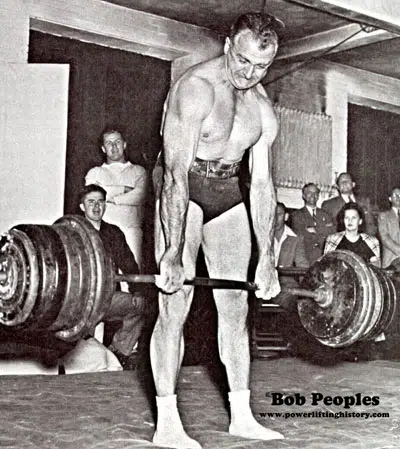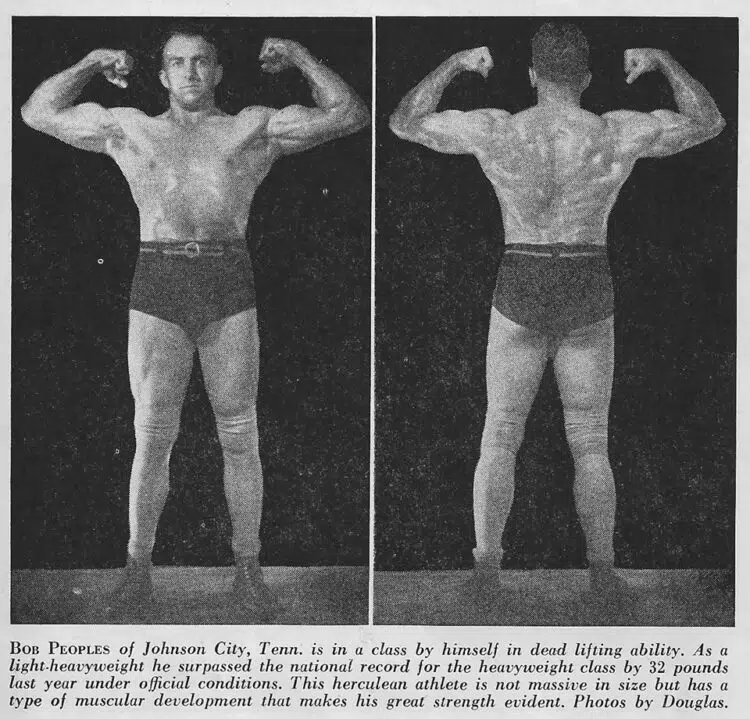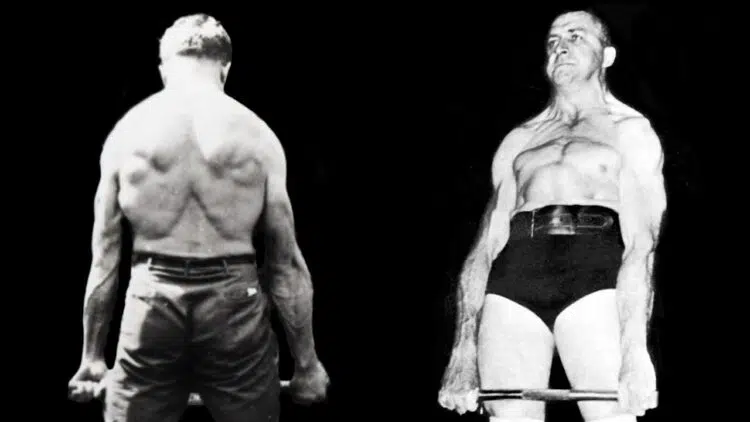Bob Peoples is a powerlifting legend that you’ve probably never heard of. The American farmer-turned-powerlifter is known for breaking the deadlift world record (WR) in the light-heavyweight and open division.
That’s not all; Peoples is credited with inventing the first-ever squat rack, power rack, trap bar, and lifting straps. He also popularized the rounded-back deadlift technique, which is now used by several elite powerlifters.
The more you read about Peoples, the more fascinated you’ll be.
Peoples was a proponent of lifting heavy. He documented his lifting journey and published several articles in popular magazines to share his knowledge and help others achieve their fitness goals.
Peoples set the then-deadlift world record of 725.75 pounds in 1941 at an 181-pound bodyweight at the age of 40.
In this article, I will take you over Peoples’ training routine and principles, uncovering his unique approaches focused on maximizing strength gains.
Level Up Your Fitness: Join our 💪 strong community in Fitness Volt Newsletter. Get daily inspiration, expert-backed workouts, nutrition tips, the latest in strength sports, and the support you need to reach your goals. Subscribe for free!
Bob Peoples’ Early Years and Foundations of Strength

Born on August 2, 1910, in Tennessee, Peoples got a bug for lifting heavy while working on his farm. Peoples’ revealed that he could deadlift 350 pounds and clean & jerk around 160 pounds early in his career, which tells us a thing or two about his natural athleticism and genetic potential.
Peoples recognized the importance of journaling early in his lifting career and logged his first workout on Nov. 1, 1935. Here are the specifics:
- Deadlift — 500 pounds
- Press and snatch — 150 pounds
- Jerk — 215 pounds
- Right arm jerk — 150 pounds
- Left arm jerk — 135 pounds
- Deep knee bend — 300 pounds
- Bent press — 125 pounds
Peoples performed these lifts at a body weight of 170 pounds. Furthermore, he got his deadlift up to 540 pounds and jerk to 225 pounds with six months of training.
Peoples was a very successful farmer, and seasonal work often interrupted his training. For this reason, he never had the ideal perfect training season, like what most elite modern-day athletes deem a necessity. Unfortunately, powerlifting wasn’t a lucrative sport back then, and there were no sponsorship deals to back athletes.
Grit and Determination
Peoples didn’t train in a high-tech facility. Most of his training happened outdoors in his yard or wherever he left his weights the night before. He moved his training equipment into a cellar during bad weather, which was usually a workout in itself, depending on the weights he was scheduled to lift in that particular workout.
Draw inspiration from Peoples’ drive whenever you think about skipping a workout after your training partner calls in sick.
Bob Peoples Inventions That Changed Strength Training Forever
Peoples’ didn’t have access to Olympic barbells or bumper weight plates. He got creative and rigged up his own equipment. While it was far from perfect, it got the job done, allowing Peoples to hone his craft and build monster strength.
Adjustable Barbell
Peoples’ first barbell was a 1¼-inch bar with wooden drums on either end. He put different objects into the drums for additional resistance. However, he later added pins to each side, which took the bar’s loading capacity up to 1,000 pounds.
Yoke
Peoples rigged up a yoke by attaching two 50-gallon drums (loaded with rocks) on platforms with a bar piercing through them to practice carrying heavy weights on his shoulders.
Squat Rack and Power Rack
This invention set the foundation for modern-day power and squat racks. Peoples set up two posts in the ground and drilled holes through them every four inches. He then inserted metal hooks into them where he could rack a barbell.
Peoples took this design a step further and created the first ever wall-mounted power rack by attaching two wooden posts to a wall. He also drilled the sides of the posts to support a pipe with the other end resting on a sawhorse of appropriate height.
“I feel this apparatus is an absolute necessity for anyone training alone as I do,” said Peoples in an article.
Trap Bar
When you work on a farm, your daily routine involves carrying heavy weights from one end of the farm to the other. Peoples got a large steel ring and fastened a short bar to each side to load weight plates. He called it the ‘ring bar,’ but it is now known as the trap bar.
Peoples performed several exercises using the trap bar, including the farmer’s walk, deficit squats, and bent-over rows.
The “Peoples” Deadlift Technique: Biomechanics and Execution
Peoples set the light-heavyweight deadlift world record in 1946, registering a massive 651-pound lift at a 175-pound bodyweight. He later beat his own record in 1947 by hoisting 710 pounds at 185 pounds bodyweight.
What’s even more impressive about his deadlift endeavors is that they came in an era when steroid use was not widespread. Don’t get me wrong, I’m not taking anything away from enhanced athletes who can lift much heavier than this.
Peoples was way ahead of his time. His meticulous training and goal-oriented programming put him in a league of his own. Furthermore, he devised unique equipment to support his training and ensure consistent progress.
Bob Peoples Deadlift Techniques
Most new-age lifters would cringe at Peoples’ deadlift form as he pulled the weights off the floor with near-straight legs and a rounded back. Peoples argued that this technique can be more effective for people with long legs and arms and short torso.
Peoples’ structure made exercises like the overhead presses inherently challenging for him. However, that didn’t stop him from winning several Olympic weightlifting titles, which comprise the snatch and clean & jerk, both of which exercises require locking out the weight overhead.
Here are the different setups Peoples used to maximize strength gains:
Deadlift Negatives
Peoples used his squat rack for the negative deadlift reps. He would load the barbell with relatively heavier weights, unrack it, walk out, lower the bar to the ground, lift it back up, and rack it. Peoples opined that deadlift negatives are one of the best ways to build overall strength.
Level Up Your Fitness: Join our 💪 strong community in Fitness Volt Newsletter. Get daily inspiration, expert-backed workouts, nutrition tips, the latest in strength sports, and the support you need to reach your goals. Subscribe for free!
Rack Pulls
Peoples soon replaced the pipes in the power rack with steel bars strong enough to withstand his one-rep max deadlift weight. Hence, the rack pulls were born. Peoples employed fast eccentrics and used the rebound from the steel bars to lift the bar to the lockout position.
Jerks
The inventor kept iterating his power rack design and added two strong leather straps to the wooden posts at head height. Peoples loaded the bar with relatively heavier weights and grabbed it with a jerk grip and stance. He then stood upright with the bar overhead.
To build lockout strength, Peoples recommended lowering the weight slightly by flexing the elbows and locking them out again. He repeated this for six reps.
Peoples recommended setting the straps at different positions to get into a lower split stance and eliminate any weaknesses. Furthermore, he suggests sliding the bar up the posts to eliminate the need to balance and focus on power generation.
Setup and Breathing Technique
Peoples deadlifted with a rounded back to compensate for his long arms and legs and short torso. The rounded back resulted in shorter levers, allowing him to lock out heavier weights with greater success.
Contrary to conventional wisdom, he didn’t take a deep breath, brace his core, and then initiate the lift. Peoples emptied all the air in his lungs before starting the lift, braced his core, and then pulled the bar off the floor.
“I feel this is much safer than following the customary advice of taking a deep breath and then deadlifting,” said Peoples.
Low Reps, High Intensity
Peoples never performed higher rep sets in his training career and instead focused on low rep sets taken close to momentary muscle failure. However, he recommended designing your training program around your unique needs and goals.
Partial Reps
Peoples relied heavily on partial rep exercises to build strength in particular ranges. He usually focused on the ranges where he struggled. This allowed him to power through the sticking points and build lockout strength.
Bob Peoples’ Deadlift Programming
Peoples’ work commitment kept him busy between 1937 and 1940, resulting in irregular workouts. However, he sporadically practiced deadlifts, which became his favorite lift. Peoples employed an overhand grip for deadlifts and did three to five reps in each set.
This is what his typical deadlift workouts looked like:
| Exercise | Sets | Reps |
| Stiff-legged deadlift negative reps | 1 | 3-5 |
| Conventional deadlift negative reps | 1 | 3-5 |
| Conventional deadlift | 1 | 1RM |
Peoples prioritized lifting as heavy as he could in each session and got his deadlift up to 600 pounds, which was made at the 1940 Tennessee State Championships and considered a Southern record.
This achievement made Peoples consider attempting a world record in either the light heavy or heavyweight class.
World Record Attempt Deadlift Training Programming
Peoples employed the following training regime in the summer of 1940 for a shot at the WR:
Day One
The first day of training comprised deadlifts and overhead presses.
| Exercise | Weight (in pounds) | Sets | Reps |
| Deadlift | 450 | 1 | 1 |
| 484 | 1 | 1 | |
| 519 | 1 | 1 | |
| 560 | 1 | 1 | |
| 584 | 1 | 1 | |
| Press | 143 | 1 | 4 |
| 153 | 1 | 2 | |
| 163 | 1 | 1 | |
| 173 | 1 | 1 | |
| 178 | 1 | 1 | |
| 183 | 1 | 1 |
Day Two
On the second day, Peoples focused on half-deep knee bends. This exercise involves squatting with the heel raised.
| Exercise | Weight (in pounds) | Sets | Reps |
| Half Deep Knee Bend | 300 | 1 | 1 |
| 490 | 1 | 1 | |
| 530 | 1 | 1 | |
| 555 | 1 | 1 |
Day Three
It comprised four exercises to work on the pressing strength:
| Exercise | Weight (in pounds) | Sets | Reps |
| Behind Neck Press | 123 | 1 | 5 |
| 133 | 1 | 2 | |
| Press | 143 | 1 | 5 |
| 153 | 1 | 2 | |
| Bench Press | 153 | 1 | 6 |
| 163 | 1 | 1 | |
| Alternate Press | 70 | 1 | 5 |
Peoples workout largely remained the same until 1942, when he had to miss five months of training due to a severe injury. His max deadlift was down to 400 pounds in 1943 after fully recovering. However, his deadlift PR was back to 600 pounds within a year.
The breakthrough for Peoples came in 1944 when he deadlifted 625 pounds for a double.
Peoples varied his workouts according to how he felt and how his body was responding to the programming. This allowed his body enough time to recover, lowering the possibility of another severe injury.
Bob Peoples’ Deadlift WR Campaign
Peoples work commitments led him to miss six months of training in 1946. However, he started training in July 1946 to set a new WR in the 181-pound weight class. But before that, Peoples set a 651-pound deadlift at a bodyweight of 175 pounds at the 1946 Tennessee State meet.
In July 1947, Peoples was deadlifting 600 pounds for five reps. However, he found it difficult to hold onto the bar, so he invented the lifting straps to eliminate his grip strength and focus on locking out the weight.
In the very same month, Peoples hit a 660-pound deadlift personal best (PB). He didn’t rest on his laurels and hoisted 675 pounds in August 1947, taking him closer to his goal.
At the Bob Hise show in October 1947, Peoples established a new 700-pound WR.
Peoples finally set the 725.75-pound deadlift WR at a bodyweight of 181 pounds at the age of 40 in 1949.
Conclusion
Peoples prowess in powerlifting and Olympic weightlifting has etched his name with the all-time greats. He was a strength sport pioneer and helped develop several training equipment and techniques that are still used today.
Peoples’ 725.75-pound deadlift WR at an 181-pound bodyweight redefined what was deemed possible. I hope Peoples’ incredible journey has motivated you to go out and train for something remarkable. Best of luck!










